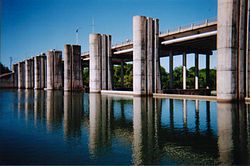History
Longhorn Dam was constructed in the late 1950s to establish a cooling reservoir for Austin's Holly Street Power Plant, a 570-megawatt natural gas and fuel oil-fired electrical power plant. The reservoir it created, Lady Bird Lake, was also originally used as a source of drinking water for the city. [1] It is not a hydroelectric dam and generates no electrical power.
In 2007, the power plant was decommissioned and subsequently demolished to make way for a new lakeside urban park; [2] today, the reservoir's major uses are recreation and fishing. The stabilization of the downtown shoreline that the dam afforded enabled substantial parkland development along the newly created lake, including Auditorium Shores and other parts of Town Lake Park. [3]
In the 2000s and 2010s, the aging dam's floodgates experienced a series of malfunctions, causing on some occasions, the loss of substantial amounts of water down the river (when gates failed to close properly).
The dam was originally constructed and operated by Austin Energy, the city power utility, but Austin Water took over operations of the dam in April 2018.
Since 2013, Austin Energy made several maintenance and upkeep projects to the dam such as replacing all major parts and rebuilding both hydraulic bascule systems. Austin Energy also repaired one of the gates and overhauled the mechanical lifting system.
City officials have estimated the cost of replacing the dam in the tens of millions of dollars. [4]
Between 2013 and 2018, Austin Energy spent $1.6 million in maintenance and repair costs.
This page is based on this
Wikipedia article Text is available under the
CC BY-SA 4.0 license; additional terms may apply.
Images, videos and audio are available under their respective licenses.

